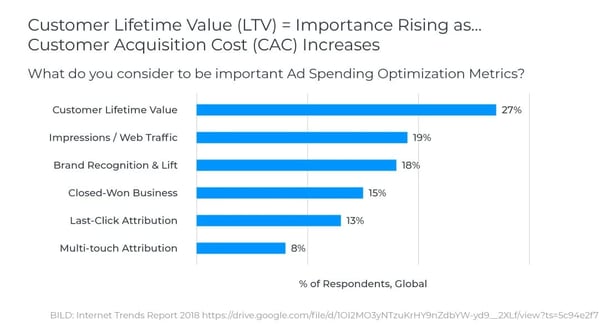
Get monthly notifications
How to optimize the lifetime value of Google Ads
Tools and technologies used by a digital agency today are more advanced than ever. But not everything is about boosting ROI, you also have to be very aware of who your customers are and spend time on making sure that you know what LTV model you should use for your business. For many e-commerce companies, LTV is the most important metric out there.
🙂
.jpg?width=610&height=333&name=how-to-optimize-the-lifetime-value-of-g-ads-01%20(1).jpg)
LTV or lifetime value, as the title suggests is the value of a customer through their entire life. Let’s say a customer is buying makeup, they’re looking for their favorite brand. They click on an ad, go through with the purchase and get the product sent to their home. If everything in the process works smoothly, it is probable that they will return in the future. Therefore, the LTV is a calculation of the total value of sales, not a single purchase.
Depending on what kind of product it is, the value of LTV can vary a lot. For products that people use a lot, like wear-and-tear products, it might be better to pay a lot to get a customer with a high potential LTV, since that customer will keep coming back. That would probably decrease your short-term ROI but would be profitable long-term. But let’s say you have a furniture business with exclusive products. For a business like this, it won’t be optimal to try to take in customers with a high LTV, since they probably won’t need a new sofa for a long time after they’ve purchased it.

Get to know your customers
It’s important you try to find out some basic information about your potential customers. It will prove inefficient to regard every customer as having equal LTV. You want to be aware of factors such as demographic and location data, the frequency of purchase and the average purchase size. That will allow you to know where to increase or decrease your marketing spend, based on your strategy setting this up in a data-driven way is the future and the only option for an E-commerce company to manage LTV in the future.
After that, you need to determine how you can, in a personalized way, reach out to your target customers. There is usually an initial long buying process for every customer, as seen in the picture below. You want to know what these customers go through during this process, like where they shop, what they shop, what works well and what doesn’t.
When you know who your high-value customers are, you can start figuring out through which channels you have the best chance to reach them. Today, a marketer at a digital agency has great tools to analyze data, but one mustn’t forget the importance of human intervention. The most successful marketing will be the one that combines minds with metrics and artificial intelligence.
Very few are able to optimize LTV in Google Ads today. People are currently only optimizing against the initial revenue or static estimates on LTV.
But everyone knows that there is more to get out from it. Keywordio has created a unique solution for this. We are offering a package/landing site in which we can set up a CTA and this solution involves -
- Measurement and analysis of data
- Set up of tracking for LTV within an ecommerce
- Measuring period and proven hypothesis
- Activation of an algorithm through data drive adjustments
Featured Articles
The Full Funnel Approach and Pinterest
Today, we're going to delve into the significance of working with a full-funnel strategy and understanding why a comprehensive media mix is crucial. We'll also explore an example of how this approach and including Pinterest in the media mix led to a significant decrease in the cost of sales for Houdini.
Master Text Overlays: Boost Ad Engagement
In recent years, capturing the attention of your target audience has become more challenging than ever. Businesses and marketers are constantly on the lookout for innovative ways to stand out in the crowded advertising landscape.
One effective technique to draw attention to your ad's message is through the use of text overlays on image and video ads. In this blog, we will explore the best practices for incorporating text overlays, ensuring your message is impactful without compromising the visual appeal of your ads.
Similar Articles
Protect Your Facebook Business Account from Phishing: Expert Tips by Keywordio
Hello everyone, Johan here from Keywordio. Today, I want to share crucial insights into phishing—what it is and how you can safeguard your Facebook business account from this prevalent threat.
Exploring the Future of TikTok: Insights from the 2024 Trend Report
Introduction
I'm excited to delve into TikTok's comprehensive "What's Next 2024 Trend Report." This report is a treasure trove for anyone in digital marketing, offering deep insights into the future of content, storytelling, and consumer engagement on TikTok.
E-Commerce Excellence: Meta's Advantage+ Shopping Campaigns Redefined
Welcome to the dynamic world of e-commerce, where Meta's Advantage+ shopping is reshaping how businesses connect with customers. In this blog post, we'll explore the key features of this innovative tool.
Introducing TikTok Shop
Today, I bring to your attention a revolutionary update from TikTok, a platform where over 150 million Americans seek daily doses of inspiration and entertainment. With a plethora of trends, fashion hacks, beauty nuggets, and a smattering of recipes, TikTok has emerged as a modern-day oracle for curious minds. The excitement in the air thickens as we unveil TikTok Shop to the US, an avant-garde conduit for folks to spot and snag their adored items seamlessly.
The Full Funnel Approach and Pinterest
Today, we're going to delve into the significance of working with a full-funnel strategy and understanding why a comprehensive media mix is crucial. We'll also explore an example of how this approach and including Pinterest in the media mix led to a significant decrease in the cost of sales for Houdini.
Master Text Overlays: Boost Ad Engagement
In recent years, capturing the attention of your target audience has become more challenging than ever. Businesses and marketers are constantly on the lookout for innovative ways to stand out in the crowded advertising landscape.
One effective technique to draw attention to your ad's message is through the use of text overlays on image and video ads. In this blog, we will explore the best practices for incorporating text overlays, ensuring your message is impactful without compromising the visual appeal of your ads.
The Next Big Thing: 5 Digital Marketing Trends to Watch for in 2023
Digital marketing is a constantly evolving field, shaped by emerging technologies, changing consumer behaviors, and the dynamic nature of the online landscape. Staying on top of the latest trends is crucial for businesses and marketers to effectively engage with their target audience and drive growth. In this introduction, we will explore some of the key digital marketing trends that have emerged in recent times.
The Power of Branding on Meta
Are you ready to unlock unparalleled opportunities and take your online business to new heights? In a rapidly evolving digital landscape, Meta continues to revolutionize the way marketers and entrepreneurs create an impact on buyers.
Today, we will talk about the immense potential of branding on Meta's platforms, Facebook and Instagram based on our Meta Branding (Online Course). Brace yourself for insights that will empower you to establish a strong brand identity, harness consumer trends, and optimize your advertising strategies like never before! Ready to spearhead your business to success? by understanding the potential of branding on Meta and how you can tap into it. Excited? So are we - let's get into it!
A Sneak Peek into Pinterest's 2023 Product Updates!
Pinterest is improving its Ads Manager to provide a seamless experience for advertisers. New features will be released throughout 2023 to optimize advertising strategies. Pinterest aims to offer powerful tools and insights for better campaign results. Get a sneak peek into the exciting updates coming to Ads Manager this year.